| Published
on 2
Dec
2015 |
All rights reserved.
|
|
|
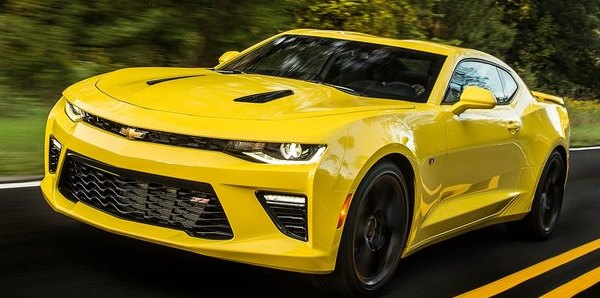 |
|
It
looks like the young Arnold Schwarzenegger in his greatest form...
|
|
It is always
interesting to read American magazines comparing Ford Mustang and Chevy
Camaro, the legendary rivalry in the last 50 years. You won’t compare
them with European or Japanese coupes because you know the pony cars
are so different from the global norms. However, recently Detroit
finally realized the need to modernize their pony cars to world
standards. The first to do that is again Mustang, whose latest model
gets independent rear suspension, Ecoboost 4-cylinder engine and a
modern shape, things that allow it to be sold globally for the first
time. GM is not planning to promote Camaro overseas yet, but it also
agrees that the 6th generation Camaro has to be a thoroughly modern
machine, all the while without losing its traditional core values. It’s
not just marketing talks, but you can feel immediately once you have
driven the new car.
At the first glance, you won’t realize the fundamental changes made
underneath the sheet metal. This is because the new Camaro looks just
like a mild facelift of the old car. More so than the old car, its
shape is blocky and outrageous. The windows and headlamps are
cartoonish shallow, exaggerating the muscular flanks, the
fire-breathing
radiator grille and the 20-inch wheels. It looks like the young Arnold
Schwarzenegger in his greatest form. Transformers should be delight to
star it once again.
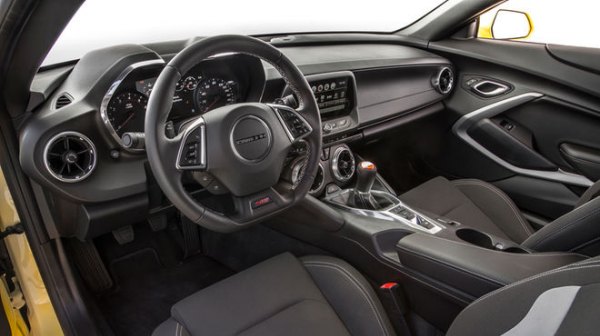 |
|
As
before, its ergonomics is poor while space is tight.
|
|
Inside, the design theme is again close to the old car, which is
dramatic rather than elegant. Materials are vastly improved for sure,
at least at where you hands usually touch, but you won’t compare it
with a BMW, of course. As before, its ergonomics is poor. The shallow
windscreen and windows make outward visibility a challenge while the
interior looks dark and cramped. The latter is not just a perception
but a fact. Sitting in the low-set driver seat, you won’t find as much
head and legroom as the latest Mustang. The rear seat is so small that
it is best to use as luggage bench. At least the driver seat is quite
comfortable and supportive (although they look cheap). Not so the
ergonomics of controls and equipment. The new infotainment screen is
strangely angled downward rather than towards the driver (obviously to
cure reflection). The middle air vents blow cold air directly to the
gearstick. For comparison, the cockpit of Mustang is roomier and a lot
more user friendly.
Good news is, its negative points are pretty much over, because its
underpinnings are modern and well engineered. Contrasting to
prediction, the new Camaro is built on the Alpha platform that
underpins GM’s premium cars such as Cadillac ATS and CTS. While its
suspensions (MacPherson struts up front and 5-link setup at the rear)
look like before, they are actually far more sophisticated. The front
struts feature aluminum links to cut unsprung weight, while its
double-pivot design introduces virtual axis to improve camber control,
just like BMW’s. The multi-link rear suspensions are made of steel, but
holes are cut from the links to save unsprung weight. Moreover, in the
V8-powered model (SS) the suspension can be optioned with Magnetic Ride
Control magnetorheological dampers to improve ride quality and body
control further. Predictably, MRC is linked up to a driver selectable
control system.
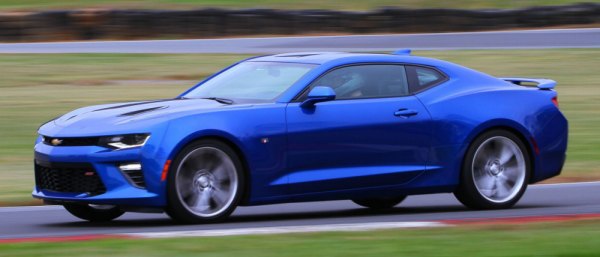 |
|
The
new Camaro is built on the Alpha platform that underpins GM’s premium
cars such as Cadillac ATS and CTS...
|
|
Another significant improvement is weight saving. The new Camaro is
made slightly smaller than the last generation – 52 mm shorter, 21 mm
narrower and 29 mm lower, with 41 mm shorter wheelbase – making it
close to the new Mustang, although still a lot larger than a BMW
2-Series. The Alpha platform means extensive use of high-strength steel
in its construction. Its monocoque chassis is therefore 60 kg lighter.
In
addition to the lighter suspension and engines, a Camaro V6 is 133 kg
lighter the car it replaces, while V8 SS trims 101 kg. That’s not
all. The lightest Camaro is now the new entry-level 2.0 Turbo, which is
177 kg lighter than the old V6! It goes without saying less weight
means faster acceleration and better handling. Equally helpful is the
new chassis’ 28-percent boost of torsional rigidity.
The aforementioned 2.0 Ecotec direct-injection turbo is added to boost
fuel economy. It comes directly from Cadillac ATS. With 275 horsepower
and more torque than even the 3.6 V6, it sacrifices little performance.
However, the V6 is definitely smoother, more eager to rev and more
delicious to listen. It is not the old V6 but the new LGW unit debuted
on Cadillac CT6. It features not only dual-VVT and direct injection but
also cylinder deactivation (or “Active Fuel Management” in GM’s words),
which effectively turns the V6 into a V4 at lighter loads. Power is
improved to 335 hp, enabling the mass-selling Camaro to do 0-60 mph
sprint in about 5.5 seconds. That’s good enough for many. Moreover, the
lighter engine allows the V6 model to steer sweeter than the V8 SS. Its
front-to-rear weight distribution is 52:48, two percent better than the
V8.
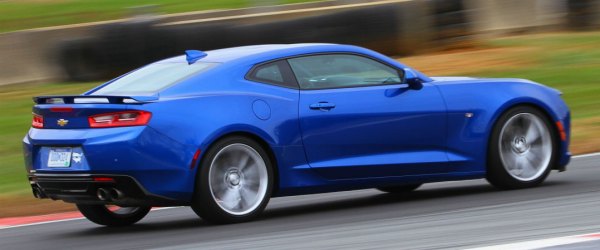 |
|
if
you buy a pony car, it has to be a V8! Sensible the V6 though, it is
not as sensible as a BMW M235i.
|
|
However, if you buy a pony car, it has to be a V8! Sensible the V6
though, it is not as sensible as a BMW M235i. If you prefer a Camaro or
a Mustang over a BMW, I suppose that is because they offer great V8
power. Compared with the Mustang’s 5-liter Coyote V8, the Chevy
small-block 6.2 is clearly the better choice. I can’t quite imagine how
GM could develop a pushrod V8 to the state that it could beat a
quad-cam V8 in every aspect – not only power and torque but also fuel
economy! The LT1 V8 on Camaro SS earns 1 mpg higher than the Mustang GT
in both EPA city and highway rating. How could it do that? The answer
is modern direct injection, variable cam phasing and again Active Fuel
Management, which shuts down half the cylinders at light loads. If
these sound familiar, it is because the engine comes directly from
Corvette. In the Camaro SS it is rated at 455 horsepower and 455
pound-foot. It doesn’t rev as high as the quad-cam V6, but it is far
more powerful and torquey at any revs. Moreover, there is no
replacement for a Chevy V8 in terms of sound, at least at this class.
Unsurprisingly, the Camaro SS is very fast. Mated with GM’s own 8-speed
automatic, it is good for 0-60 mph in merely 4 seconds. Yes, 4 seconds
flat! The ton is reached at 9 seconds. We don’t know how the blocky
shape could affect its aerodynamics, but 170 mph should be no problem,
considering a Lamborghini Countach with as much power and 0.42 Cd did
185 mph. The other gearbox, Tremec 6-speed manual, is slightly slower
to 60 mph. However, keen drivers should enjoy the extra involvement it
brings, because the automatic’s paddle-shift override is nowhere as
responsive. The Tremec box has good shift quality, with a short throw,
a nicely modulated clutch pedal and clever automatic rev-matching.
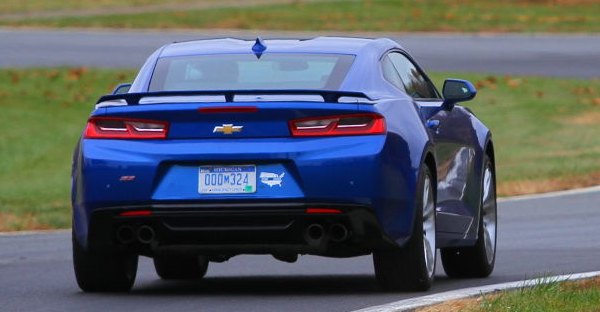 |
|
The
real surprise is the chassis, because it has no traces of pony cars at
all...
|
|
However, the real surprise this time around is the chassis, because it
has no traces of pony cars at all. The Camaro’s structure feels solid,
and its suspension offers excellent damping and body control. Pitch and
roll are tightly controlled, while road imperfections are nicely
smoothed out by the magnetic dampers (passive suspension rides good
enough, if not exceptional). The fat rubbers offer strong front-end
grip. The steering, though electric-powered, is fast and accurate. This
means the nose responds to your commands crisply and slips into corners
eagerly. The car feels more precise, controlled and composed than pony
cars have any rights to be. Comparatively, Ford Mustang feels softer
and looser. The standard 4-piston Brembo brakes on Chevy are powerful
and dependable.
The Camaro SS is not a Lotus Elise. It prefers slow-in, fast-out
technique like any powerful FR coupes. It displays a bit understeer
when pushed into corners, but then you can balance it with throttle.
With so much grunt from the V8, and an unobtrusive traction control, it
will be happy to hold the drift in fast corners.
Driving on tracks or demanding roads, the Camaro is definitely the
better, sportier car than Mustang. On the flipside, its cabin is
flawed, and it lets too much wind and road noise penetrating into the
cabin, so it is not as good as the Mustang as a grand tourer. Besides,
it is also priced higher, especially the V8. Is it worth the
compromises? The answer should be yes if you are keen drivers. Most
important, the compromises are no longer associated with dynamics,
something we could not imagine for pony cars a few years back. Detroit
has really changed.
|
Verdict:     |
Published
on 23
Dec 2016
|
All rights reserved.
|
|
Camaro ZL1
|
|
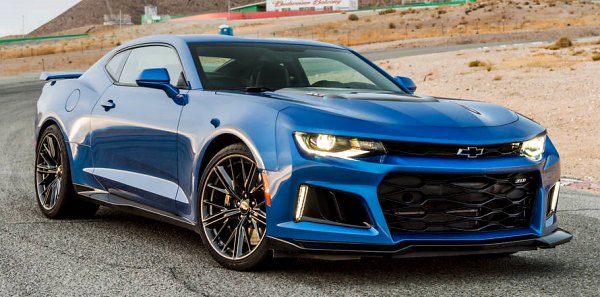
|
|
Now
the ZL1 gets not only power but also a chassis to match.
|
|
It lapped Nurburgring
Nordschleife in 7:29.61. We are not talking about a GT-badged Porsche,
a carbon McLaren or a Godzilla GT-R, but an American muscle car. Not
just a muscle car, but one built on the basis of a mass production pony
car. Maybe the world has gone crazy…
This is the second Chevrolet Camaro ZL1 we know. The first one arrived
6 years ago and it was already a shock to us. It was powered by a
version of the top Corvette ZR1 engine, i.e. a supercharged 6.2-liter
V8 good for 580 ponies. It had adequate chassis upgrades, too,
including advanced magnetorheological dampers and large Brembo brakes.
However, the old ZL1 was heavy, and its Holden-Commodore-derived
chassis was not advanced enough to match its power.
The new ZL1 is different. Like all its Camaro siblings, it sits on the
modern Alpha platform (see main article above), being a lot stiffer and
lighter – some 90 kg in the case of ZL1. The suspensions are more
sophisticated, with double-pivot struts up front to improve camber
control, and less unsprung weight to deal with. Meanwhile, its engine
gets even more powerful. Save the wet sump lubrication and a few
peripherals, it is exactly the same as the LT4 unit of Corvette Z06.
Output figures are also exactly the same, with 650 horsepower released
at 6400 rpm and 650 lbft of torque available at 3600 rpm. That’s a
whopping 70 hp and 94 lbft more than the old engine with which it
shares the same capacity and layout. It is still a good old GM small
block, relying on a single block-mounted camshaft to drive 2 valves per
cylinder through long pushrods. However, this one might surprise you
with the addition of direct fuel injection and cylinder deactivation –
despite that, it fails to escape from the gas-guzzler tax in the US.
Never mind, the super Camaro is good for 0-60 mph in 3.5 seconds, and
it hits 100 mph 4 seconds later. It is significantly faster than the
old ZL1, faster than Ford Mustang GT350 and even Dodge Challenger
Hellcat. Most important, the LT4 roars like a NASCAR engine.
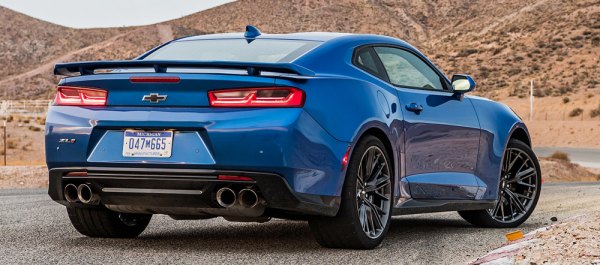
|
|
This
is an American muscle car that can lap Nurburgring in 7:30!
|
|
Part of the uncanny acceleration is contributed by the 10-speed
automatic gearbox called Hydra-Matic 10R90. It is a new development
done jointly by GM and Ford, and will be used on Mustang as well as
many trucks of the two groups. By the way, it just beats the Aisin
transmission of Lexus LC to the market to be the world’s first
production 10-speed automatic. Not only the closely-stacked ratios aid
acceleration and smoothen the progress, the last 3 ratios are
overdrive, so to enhance fuel economy and refinement in cruising. Its
control algorithm is clever, automatically switching to a sportier
shift pattern when it senses your intention. It will downshift straight
from 10th to 3rd and hold the gear in corners. It will blip throttle
during downshift to match rev. So smart and quick that the mighty ZF
8-speeder finally has a strong rival. The only downside is the
paddle-shift manual mode not so quick or obedient. If you want more
control, you might need to choose the good old Tremec 6-speed manual,
but it won’t be as quick as the auto.
Better news is, the chassis is finally able to match the power. The
stiffer construction helps a lot, as is the new generation Magnetic
Ride Control suspension (which responds 40 percent quicker), larger
Brembo brakes (front discs upsized from 370 to 390 mm), new electronic
LSD and improved Performance Traction Management (which offers 5 levels
of setting). Compared with the old car, the handling is more neutral,
with much less understeer to deal with in fast corners, although the
last track-oriented Z/28, with its wider and stickier front tires,
remains the best balanced Camaro in memory. The ZL1 corners flatly,
offers dependable grip and strong braking. Its steering is heavy but
precise and quick, thanks to the mechanical variable-ratio rack.
Steering feel is better than BMW M4, if not Porsches or Lotus. For a
pure road car, it has a respectably high cornering limit, which
explains its remarkable Nurburgring lap time. When it oversteps the
limit, it runs into a smooth breakaway which can be adjusted with
throttle. It is able to dance! Nevertheless, on a tight mountain road
its talent is limited by its excessive width, poor visibility and a
firm ride. The 1800 kg of mass also hurts its agility. No one would
confuse it with a Porsche or Lotus.
The ZL1 is cheaper than those European prestigious sports cars, of
course. However, starting at $63K it is not quite as bargain as the
$50K Mustang GT350. An M4 costs just about the same, while C63 S Coupe
is not far above. You have to love its outrageous look to forgive its
cheap interior and all the packaging shortcomings.
|
Verdict:     |
Published
on 17
Jul 2017
|
All rights reserved.
|
|
Camaro ZL1 1LE
|
|
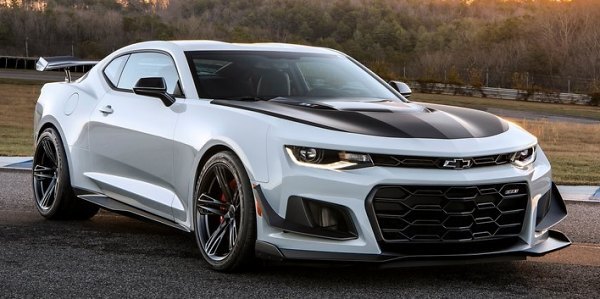
|
|
This
is a pony car that laps Nurburgring in 7:16, faster than a 911 GT3 RS!
|
|
In a perfect world a
track-oriented machine should be a thoroughbred sports car like 911 GT3
RS or AMG GT R. You would not derive it from a 1.7-ton-plus American
muscle car, would you? With lots of mass to handle, you need more
power, more brakes, more tires and more everything, yet it would be
difficult to hide its weight in the twistier sections of the track.
Moreover, with a weight distribution heavily biased towards the front
axle while all those mega pound-foot of torque go through the rear
wheels, the car would struggle to put down the power. If physics is
correct, the Camaro ZL1 1LE would be a nightmare to drive.
Somehow, 3 years ago General Motors did almost the same thing to the
last generation Camaro Z/28,
and it was surprisingly good to drive on track. The new ZL1 1LE is a
little bit different though. While the Z/28 employed a 7-liter
naturally aspirated LS7 V8, the new car sticks with the 6.2-liter
supercharged LT4 V8 of the regular ZL1. It pumps out the same 650 hp
and 650 lbft of torque as the standard car. Huge output, but no news
anyway. The fact that it offers 170 lbft more torque than the old
engine – and way more at lower rpms – should put more pressure to the
rear-wheel-drive chassis.
Although GM always says its 10-speed automatic gearbox is faster, the
track-oriented machine is offered with only the Tremec 6-speed manual.
Its 6th gear has been lowered to aid setting a Nurburgring lap record,
but aside that it is just the same as the manual box on the standard
ZL1. Because the powertrain is carried over, the 1LE is marketed as a
track package of ZL1 rather than a standalone model like the Z/28. In
other words, it is just like Ford Mustang GT350R.
Speaking of GT350R, the ZL1 1LE is slightly more expensive than its
rivals at $71,000 versus $64,000, but it is still a bargain considering
the performance it offers. For similar straight line speed and lap
time, you need six-figures prices from any European machines. So how
fast is it? 0-60 mph taking 3.6 seconds might not be headlines today,
but a Nurburgring lap time of 7:16 is. It is 21 seconds faster than the
Z/28, 13 seconds quicker than the ZL1 and a second ahead of 991 GT3 RS
(although the new GT3 4.0 is quicker again at 7:12.7). And that's a
1732 kg machine! What has GM done to its chassis?
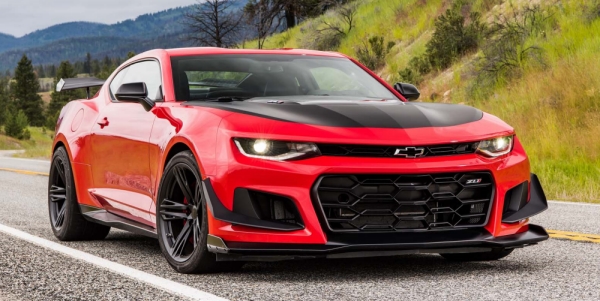
|
|
Great
handling on track. Poor ride comfort on road.
|
|
The first thing is aero. A larger front splitter, additional guiding
vanes and a fixed carbon-fiber rear spoiler double downforce to 136 kg
at 150 mph. Then the tires are replaced with track-oriented Goodyear
Eagle F1 Supercar 3R, i.e. a brand-new alternative to the usual Michael
PS Cup 2 or Pirelli P-Zero Trofeo R (Z/28 used the latter). Moreover,
they get 20mm wider both front and rear to 305 and 325mm, respectively.
Chevy said they are good for 1.1g of lateral acceleration. In order to
save unsprung weight, the wheels are an inch smaller at 19-inch, and
are made of forged alloy. However, the most important change is the
suspension. Like Z/28, it employs Multimatic’s DSSV dampers, which
offer different compression and rebound characteristics for high speed
and low speed, although the damping is not adaptive like the Magnetic
Ride Control of ZL1. Besides, the suspensions have ditched rubber
bushings and are mounted rigidly to the chassis for more precision. As
it is designed for track use, the front suspension’s camber and travel
are adjustable in garage, whereas the stiffness of rear anti-roll bar
is also adjustable, so you can fine tune the balance of the chassis to
suit the track.
On the downside, the 1LE is not a stripped-out conversion. It is only
27kg lighter than the standard car thanks to thinner rear glass and a
fixed-back rear seat, whereas all other equipment and comfort features
are
retained. Another disappointment is the lack of carbon-ceramic brake
option. Although the ZL1’s Brembo brakes already employ huge steel
discs, they are not fade-resistant enough for lap after lap of track
abuse.
How does the car behave on track? Apart from the brakes, pretty good
actually. Body roll is well contained by the stiff suspension. The 3R
tires offer tremendous grip and progressive breakaway when its high
limit is exceeded. The car is heavy but it balances well, with just a
hint of understeer approaching the bend. With so much torque, you can
spin the rear wheels and get into sudden oversteer if you are stupid
with throttle, but track-day drivers should be able to manage. The
steering feels faithful, and the gearshift is refined. Pony cars have
never offered such a high level of finishing.
Nevertheless, being used as a road car the 1LE is not as good. Its ride
is really hard, so punishing that you will back off to deal with any
bumps or expansion joints on the road. There are few cars in recent
memory ride as hard. While Porsche and many European rivals have
managed to combine tight body control with everyday-usable ride
comfort, the track-oriented Camaro hasn’t yet. Blame to the fact that
it lacks adaptive dampers and that its suspension is tuned primarily
for track. Well, GM might say you can always opt for the regular ZL1 if
road use is your primary concern, but a versatile road-and-track car is
certainly more enjoyable for more time. After all, this is not a race
car. For this reason, I think the ZL1 or GT350R are better options.
|
Verdict:    |
|